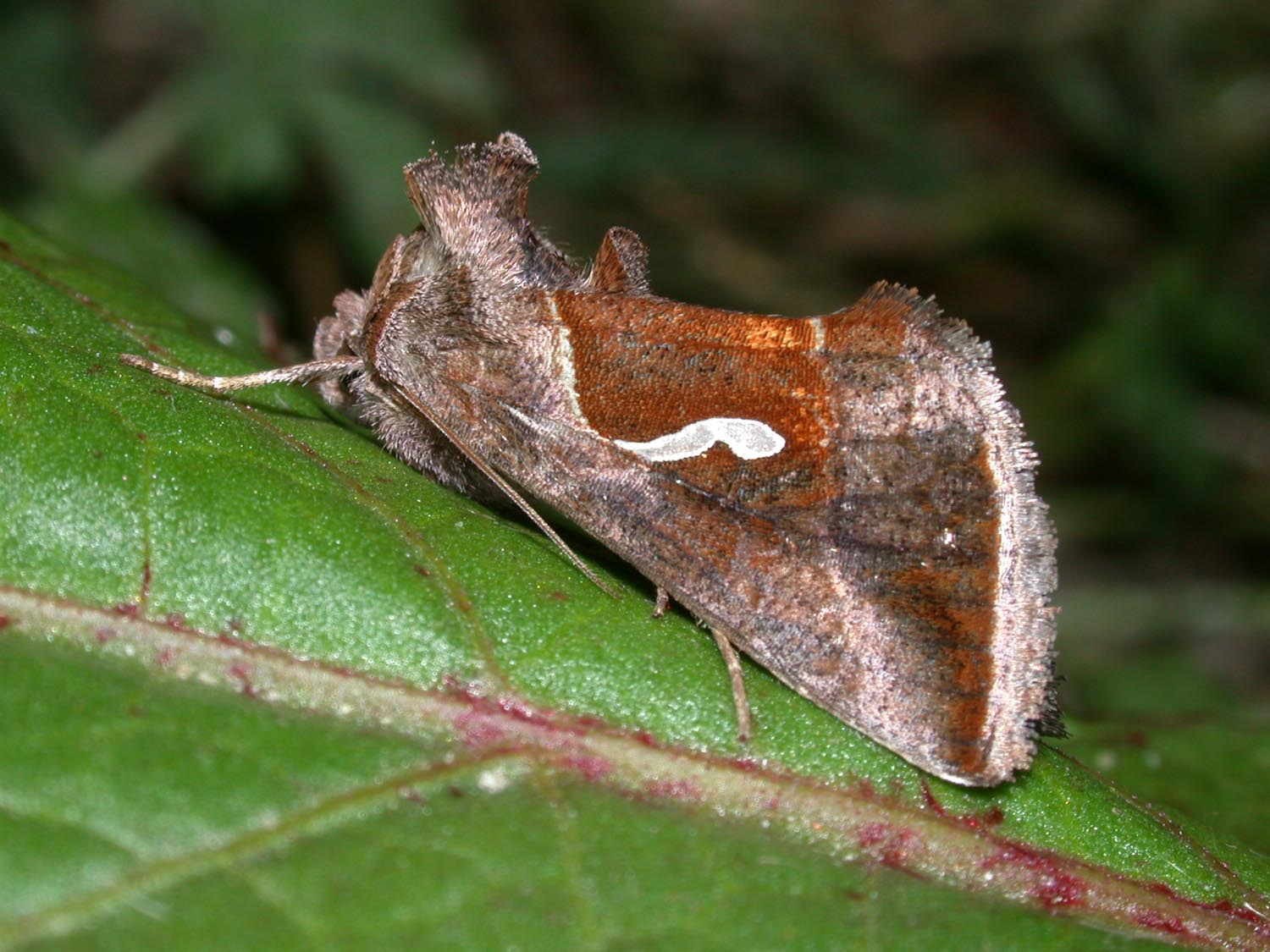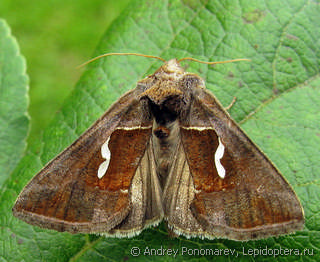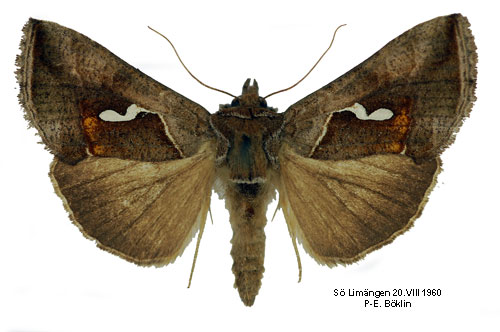Macdunnoughia confusa
Yarrow - syllable Owl ( Macdunnoughia confusa )
The yarrow syllable Owl, also field perennial grass - syllable Owl, Silberkommaeule ( Macdunnoughia confusa ) is a butterfly (moth ) from the family of cutworms ( Noctuidae ). He is active at night, crepuscular and diurnal.
- 5.1 Literature
Features
The wingspan of the butterfly is 36 to 42 mm. Head and chest area are chocolate brown. On the chest there are two cusps. The anterior cusp is semi-circular bent backwards. The ground color of the forewings varies from gray-brown to dark brown. The front wing is divided by two transverse lines, ranging from about the middle of the wing to the trailing edge. The inner transverse line runs obliquely backwards. It is white and clearly marked. The outer transverse line is slightly wavy and runs approximately parallel to the hem. She is thin and hardly highlighted in color, usually lighter. You still can be seen clearly by the color change from midfield to the outfield. Occasionally it is wider towards the trailing edge and becomes an elongated white, thin spot. Alfeld the disc has a large, elongated, white, slightly curved patch ( "Gamma" ), which is characteristic of the species. The hem line is often much brighter, the fringes usually light gray. The golden-brown hind wings are slightly darker towards the outer edge. The undersides of the forewings are reddish brown and are also darker towards the edge. It is a darker outer transverse line available as well as a more or less clearly marked, small Diskalfleck. The caterpillar is pale to greenish gray, and gray to brownish gray with bright side stripes that are edged to the back darker. The head has on the side of each a black stripe. The topline is dark green, but indistinct whitish limited, the addition ridge lines indistinct whitish. The point warts above the lateral line are mostly black, as is the sternum and the head. The doll has a greenish white to light brown underside and a black back.
Similar Species
The yarrow syllable Owl resembles the Gammaeule. However, it is smaller and clearly distinguished by the different shape of the gamma of this.
Geographic and habitat
The type currently seems to be understood in the propagation. At the beginning of the 19th century the type was only rarely to southern Germany. Beginning of the 20th century were settled northern Germany and southern Scandinavia. However, it is difficult to find the actual northern boundary up to which the species is also down to earth to be completed, the kind every summer flies far to the north and there is also a consequence of generation. The caterpillars do not survive but then the winter and the population is then rebuilt in the following year of immigrants. Today, it is almost spread throughout Europe and probably in most countries with the exception of northern Scandinavia and northern Russia also down to earth. It is very rare in the British Isles and probably there also not down to earth. In the east the area of distribution on the front and central Asia extends to Kamchatka, Japan, China and Korea.
The species prefers the climate warmer parts of Central Europe and has also colonized this first. The species seems to be slightly more common in open grasslands or low wooded regions. So they come to dry meadows, dry grasslands, slopes, embankments, flood embankments, sand corridors, field margins, fallow land, ruderal areas, gardens and dumps more common. Wet and moist areas are largely shunned except for the fly-through and possibly also visiting flowers. In the Central German Uplands it rises to about 1000 m altitude in the Alps to about 1200 m.
Way of life
The species forms in Europe two generations, in climatically favorable areas also three generations. In favorable years, even up to four generations are likely to be possible. The populations living in Europe are reinforced by immigrants from southern Europe. It can be observed from late March to late October through the butterflies almost continuously. They are good fliers that are diurnal, crepuscular and nocturnal. Visit flowers at night and are attracted by light sources. However, they can not bait by sugar. The eggs are laid singly on the caterpillar food plants. The caterpillars live polyphagous on a large number of various herbaceous plants. Detected are eg the stinging nettle (Urtica dioica), Common Clematis (Clematis vitalba ) Real hair strand ( Peucedanum officinale), Purple Dead Nettle ( Lamium purpureum ), Yarrow (Achillea millefolium ), wormwood (Artemisia absinthium ), field - mugwort (Artemisia campestris ), Fox cal ragwort ( Senecio fuchsii ), endive ( Cichorium endivia ) and many others The caterpillars overwinter. Pupation occurs in a cocoon on the ground.
System
According to the large area of distribution and variability exist a number of synonyms. Previously, the species was assigned to the genus Plusia.









